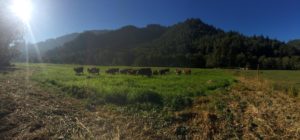
Perched on a log at an early summer bonfire, with bottles of Malbec in hand, we’re watching the brightest planets rise and laughing at the antics of children up way past their bedtime. Over at the grilling fire – the carefully tended fire of homemade hardwood charcoals we call leña – sizzling pieces of steak lightly crusted in seasalt are being heaped on plates and passed around. We tear off chunks of warm bread and gobble up slices of chorizo waiting for the plates of steak to reach us. There’s nowhere I’d rather be.
I first fell in love with the Argentine style of BBQ – the Asado – my first trip to South America in 1995. Over the years, each subsequent trip and my engagement with the Argentine community in Portland expanded my appreciation for this communal ritual. I’ve been inspired by the passion with which my Argentine friends devote themselves to debating each detail – the making of the charcoal, the quality of the coals, the design of the grill or ‘parilla’ and of course, how to cook the meat. Depending on who you talk to, these experiences may have been the driving force for us to buy a grassfed beef operation on the beautiful North Coast of Oregon.
The ingredients are simple: quality meat, salt, fire. Bread, wine and, here in Nehalem, we’ve added roasted vegetables to round out the meal as a nod to my wife’s vegetarian past and our many vegetable farming friends on the North Coast. It really comes down to taking your time to enjoy the landscape, the company, the ritual and eating as the cuts are ready. In my experience it is more forgiving to serve small bites right off the grill.
One of Argentina’s most famous chefs is Francis Mallmann. A few years ago he made a television series called Fires of the South which explored wood-fired cookery throughout the wilds of Patagonia. He showed us cooking in situ on the beach, in the woods, along the river over a well-made fire using cast iron plates called chapas or skillets or cooking ‘a la vara’, a wooden post and skewer set-up. That gorgeous series coalesced in the pages of his Seven Fires cookbook. It was that rich and poetic read that inspired us to take our asado tradition with friends and family to the next level.
Our ranch is nestled in a valley bordered to the north and south by the Tillamook State Forest. On the southern edge of the pastures, the Nehalem River rushes or meanders by depending on the season. In the fall there are Chinook, in the spring Steelhead, in the summer crawdads. Some days the wind howls out of the sea from the west tearing down branches and depriving us of electricity. Some days the sun gently warms the pastures and the bugs hum and the barn swallows chase each other around the sky. And every day I journey between my house, the barns and the cattle pastures, evaluating the grass, planning the rotations. I pass the beehives our friend has set-up in the eastern pasture near the willows. I pass the vegetable fields of Green Fork Farm and Sustaining Space Farms co-located on the ranch. And I’m struck by how beautiful this place is. How lucky we are to live here and be in life with this community.
The Vaca Entera Asado – or whole cow roast – is a celebration of all these things. The recipe, adapted directly from Mallmann’s Seven Fires, has 3 ingredients: 1 medium cow (butterflied), 2 gallons of salt water. 2 gallons of chimichurri. To perform the recipe — and a performance indeed it is — requires 2 cords of hardwood logs, a stout roasting contraption with block and tackle (our friends at Del Fuego Iron Works are the go-to source), pliers, shovels, axes, a team of 6 or so and enough wine, sleeping rolls, coffee, mate, music, stories and food to entertain the crew for a full 24-hour day.
It is beautiful and challenging. It requires the support of many friends, teamwork and collaboration to assemble the equipment and the dishes. It asks us to be in this place for several days and appreciate the shifts in the direction of the wind, the various moods of the light and sounds as we work to tend the fire. It asks us to be in this place where the cattle are born, live and where they die as well. We sit and sleep on the ground where the vegetables are grown and we’ll sweeten our bread with honey from the bees who are worrying at our leftovers. It is a celebration of the animal and the rancher, the chefs and roasting crew, a skilled local butcher like Tillamook Meat, the community around us and this life we’ve made here.
Leave a Reply